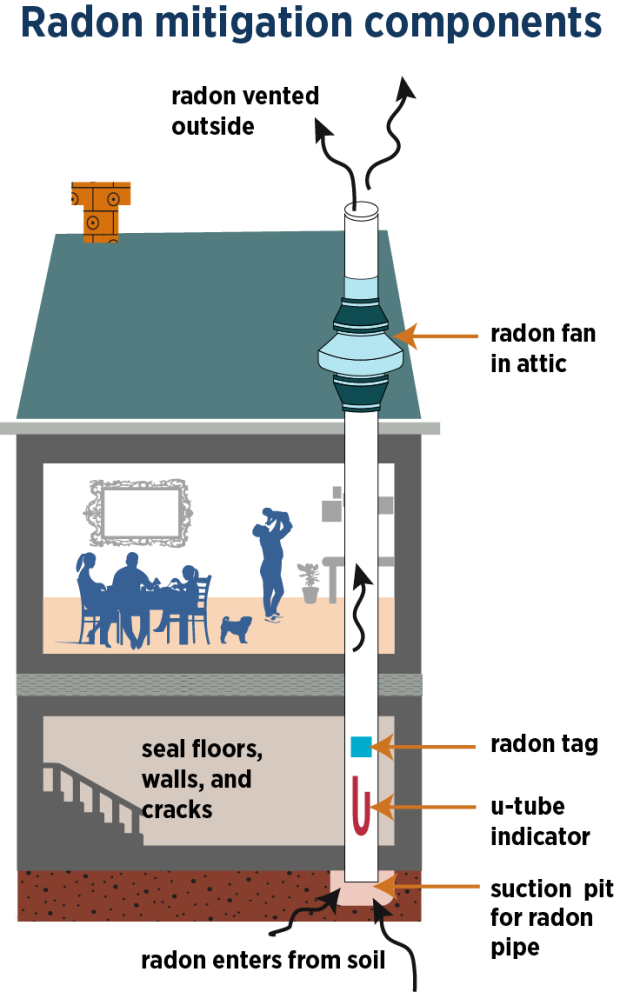Do I need to fix my home?
Radon in the air is measured in “picocuries per liter of air” or pCi/L. The level of radon in outdoor air is about 0.4 pCi/L. No home will have 0 pCi/L.
The U.S. EPA has set the “action level” for radon at 4 pCi/L. You should fix (“mitigate”) your home if radon is above the action level. No level of radon is risk-free, so the EPA recommends that you consider action if your home’s radon level is between 2 and 4 pCi/L.
How do I fix (“mitigate”) my home?
You should hire a certified mitigation specialist. Make sure the person is certified by either the National Radon Safety Board (NRSB) or the American Association of Radon Scientists and Technologists - National Radon Proficiency Program (AARST-NRPP). A system that is incorrectly designed or installed can make the problem worse. The Massachusetts Radon Hotline (800-723-6695) can give you a list of certified mitigation specialists.
The certified mitigation specialist will design and install a radon mitigation system. A mitigation system can usually be installed in less than a day. Most radon mitigation systems use a fan to create suction or a vacuum under the home’s slab. This suction action is called active sub-slab depressurization. The radon gas is released outside, above the roof line.
Have the specialist visit your home before they give you a bid. It’s a good idea to get more than one bid. The con- tract should have a warranty to get the home’s radon level below 4 pCi/L, and ideally below 2 pCi/L. It should also include a warranty for the fan.
For additional information on selecting a contractor, see the Environmental Protection Agency’s Consumer’s Guide to Radon Reduction: How to Fix Your Home (PDF).
What does a mitigation system cost?
Most mitigation systems cost between $1,000 and $1,500. The cost will depend on your home’s size, foundations, whether there are any crawlspaces, the number of floors, and how many suction points and/or fans are needed.
What should I do after the mitigation system is installed?
Test your home for radon between 24 hours and 30 days after installation. If the mitigation system is installed in warm weather, you should also test in the winter (between November 1 and March 31). Then re-test your home every year or two to make sure the system is still operating properly.
Radon Mitigation Checklist
Check for the following:
- The installer is certified by either NRSB or AARST/NRPP.
- The mitigation system is clearly labeled “Radon Reduction System.” Labeling the system will prevent a plumber from accidentally connecting to the system for a different use.
- A radon test was done after installation.
- The mitigation system was installed in accordance with all electrical codes.
- The radon system discharges above the edge of the roof and meets current guidance.
- The fan is in a ventilated attic or on the exterior of the home.
- There is a warning system, such as a pressure gauge installed to monitor the system, to alert you if the fan stops working.
- The mitigation specialist explained how to read the pressure gauge.
- There is a label on the system showing the installer’s name, phone number, and certification number.
- The date of last radon test is visible on the system. If the system was installed in warm weather, be sure that a test was done in the winter.
- Re-test your home your home every year or two to ensure the system is working properly.
For more information about testing or fixing radon in your home, visit www.mass.gov/radon. If you have questions, call the Massachusetts Radon Hotline at (800) 723-6695.
Additional Resources
-
Open PDF file, 341.87 KB, Fixing Radon in Your Home (English, PDF 341.87 KB)
Contact
Online
Phone
or
The operating hours are Mondays through Fridays from 8:45 a.m.-5 p.m. Please leave a message including your phone number and you will receive a call back.
